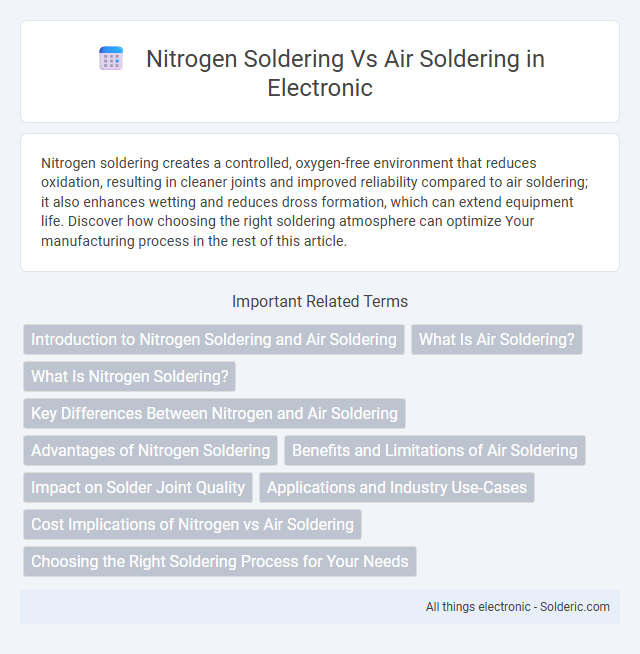Nitrogen soldering creates a controlled, oxygen-free environment that reduces oxidation, resulting in cleaner joints and improved reliability compared to air soldering; it also enhances wetting and reduces dross formation, which can extend equipment life. Discover how choosing the right soldering atmosphere can optimize Your manufacturing process in the rest of this article.
Comparison Table
| Aspect | Nitrogen Soldering | Air Soldering |
|---|---|---|
| Atmosphere | Inert nitrogen gas environment | Ambient air environment |
| Oxidation Control | Excellent oxidation prevention | High oxidation risk |
| Solder Joint Quality | Superior, clean joints | Possible flux residues and dross |
| Equipment Cost | Higher due to nitrogen supply | Lower initial cost |
| Process Efficiency | Faster, reliable reflow, less defects | Slower, potential rework needed |
| Environmental Impact | Reduced flux fumes and emissions | Higher emissions of flux smoke |
| Common Applications | High-reliability electronics, aerospace | Standard consumer electronics |
Introduction to Nitrogen Soldering and Air Soldering
Nitrogen soldering uses a controlled nitrogen atmosphere to reduce oxidation during the soldering process, resulting in improved joint quality and reduced post-solder cleaning. Air soldering, in contrast, occurs in ambient air, which can lead to increased oxidation, potentially affecting solder joint reliability and necessitating more cleaning. Your choice between these methods depends on factors like production volume, joint quality requirements, and cost considerations.
What Is Air Soldering?
Air soldering is a traditional soldering technique that uses ambient atmospheric air to heat components and melt solder. Unlike nitrogen soldering, which employs nitrogen gas to create an inert atmosphere reducing oxidation, air soldering relies on unfiltered air, often leading to higher oxidation and potential defects in solder joints. This method is generally less costly but may require additional cleaning processes to ensure solder quality.
What Is Nitrogen Soldering?
Nitrogen soldering involves using nitrogen gas to create an oxygen-free atmosphere during the soldering process, which prevents oxidation and improves joint quality. This method enhances solder flow, reduces dross formation, and results in stronger, more reliable electronic connections compared to air soldering. Nitrogen soldering is particularly advantageous in high-precision applications where consistent soldering performance and minimal defects are critical.
Key Differences Between Nitrogen and Air Soldering
Nitrogen soldering utilizes an inert nitrogen atmosphere to reduce oxidation and improve solder joint quality, whereas air soldering relies on ambient air, increasing the risk of oxidation and potential defects. Nitrogen soldering typically results in faster preheating times and cleaner solder joints, enhancing overall process efficiency and reliability. In contrast, air soldering is more cost-effective but may require additional flux and post-processing to address oxidation-related issues.
Advantages of Nitrogen Soldering
Nitrogen soldering enhances solder joint quality by reducing oxidation, resulting in cleaner and stronger connections. It improves thermal efficiency by providing a controlled atmosphere, which minimizes heat loss and promotes uniform soldering temperatures. This process also reduces flux residue and solder defects, leading to higher reliability and less post-soldering cleaning.
Benefits and Limitations of Air Soldering
Air soldering offers cost-effectiveness and ease of setup by using ambient air instead of nitrogen, reducing operational expenses for small-scale or prototype assembly. However, it faces limitations such as increased oxidation during soldering, leading to poorer joint quality and higher defect rates compared to nitrogen soldering. The absence of an inert atmosphere in air soldering challenges the achievement of consistent, high-reliability solder joints, especially in high-volume or sensitive electronic manufacturing.
Impact on Solder Joint Quality
Nitrogen soldering significantly improves solder joint quality by reducing oxidation and promoting better wetting, resulting in stronger, more reliable connections with fewer defects. Air soldering exposes solder joints to oxygen, increasing the risk of oxidation and causing weaker joints with higher rates of solder balling and voids. The enhanced atmosphere control in nitrogen soldering leads to improved solder fillet formation and minimizes the need for flux, thereby reducing residue and enhancing overall joint integrity.
Applications and Industry Use-Cases
Nitrogen soldering is widely utilized in high-precision electronics manufacturing, such as semiconductor and PCB assembly, where it reduces oxidation and improves joint quality, enhancing reliability in aerospace and medical devices. Air soldering, commonly applied in general electronics and automotive industries, suits applications with less stringent soldering environment requirements but may face higher oxidation rates affecting long-term durability. Both methods serve distinct industry needs, with nitrogen soldering favored for high-value, sensitive components and air soldering employed in cost-effective mass production settings.
Cost Implications of Nitrogen vs Air Soldering
Nitrogen soldering typically incurs higher initial costs due to the need for gas supply systems and specialized equipment compared to standard air soldering. However, enhanced solder joint quality and reduced oxidation in nitrogen environments can lead to lower defect rates and rework expenses, potentially offsetting upfront investments. Air soldering offers lower setup costs but may increase long-term costs through higher maintenance and quality control efforts due to oxidation-related issues.
Choosing the Right Soldering Process for Your Needs
Nitrogen soldering improves joint quality by reducing oxidation and enhancing wetting, making it ideal for high-reliability electronics and fine-pitch components. Air soldering is cost-effective and simpler to implement, suitable for general applications where oxidation control is less critical. Selecting the right soldering process depends on factors such as device sensitivity, production volume, and desired solder joint consistency.
Nitrogen soldering vs air soldering Infographic

 solderic.com
solderic.com